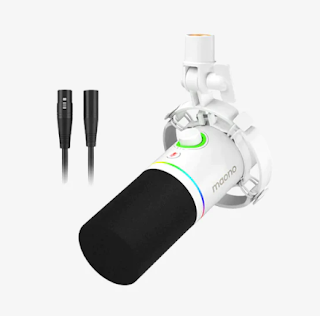Unveiling the Power of Dynamic Microphones: Your Complete Guide
Dynamic microphones are a
ubiquitous and essential tool in the world of audio recording and live sound
reinforcement. Known for their durability and versatility, these microphones
are favored by musicians, broadcasters, and audio engineers alike. In this comprehensive
guide, we'll delve into the world of dynamic microphones, exploring how they
work, their applications, and the top models available today.
Understanding Dynamic
Microphones:
1. How Dynamic Microphones Work:
dynamic
microphone operate on electromagnetic induction. When
sound waves hit the microphone's diaphragm, it moves a coil of wire within a
magnetic field, generating an electrical current that mirrors the sound wave.
2. Durability and Reliability:
- Dynamic microphones are robust and can handle high sound pressure
levels without distortion, making them ideal for stage performances and
capturing loud sound sources.
3. No Need for External Power:
- Unlike condenser microphones, dynamic microphones do not require external
power sources like phantom power. They can be connected directly to a mixer or
amplifier.
Applications of Dynamic
Microphones:
1. Live Sound Reinforcement:
- Dynamic microphones are the go-to choice for miking live musical
performances, including vocals, drums, and guitar amplifiers, due to their
ruggedness and resistance to feedback.
2. Studio Recording:
- While condenser microphones are common in studios, dynamic microphones
find use in recording instruments like electric guitars, snare drums, and bass
amplifiers, providing a punchy sound.
3. Broadcasting and Podcasting:
- Many radio hosts and podcasters rely on dynamic microphones for their
durability and ability to reject ambient noise.
4. Instrumental and Vocal Amplification:
- Dynamic mics are often used to amplify musical instruments, such as
harmonicas, brass instruments, and percussion.
Top Dynamic Microphones on the
Market:
1. Shure SM58:
- Renowned for its durability and clear vocal reproduction, the Shure
SM58 is a staple on stages worldwide.
2. Sennheiser MD 421 II:
- This microphone is prized for its versatility, excelling at capturing
vocals, drums, and guitar amps.
3. Electro-Voice RE20:
- The RE20 is a broadcast standard, known for its warm and smooth sound
quality.
4. AKG D112:
- A favorite for kick drum miking, the AKG D112 provides punchy low-end
response.
Tips for Using Dynamic
Microphones:
1. Close-Miking Technique:
- Keep the microphone close to the sound source for better isolation and
reduced ambient noise pickup.
2. Windscreen and Pop Filter:
- Attach a windscreen or pop filter to minimize plosive sounds and
protect the microphone from moisture.
3. Proper Handling:
- Dynamic microphones are rugged, but gentle handling ensures longevity.
Avoid dropping or subjecting them to extreme conditions.
Conclusion:
Dynamic microphones are an
integral part of the audio industry, offering reliability and versatility in a
variety of applications. Whether you're performing on stage, recording in the
studio, or broadcasting your voice to the world, a quality dynamic microphone
is an essential tool for capturing sound accurately and effectively. With an
array of options available, you can find the perfect dynamic microphone to suit
your needs and elevate your audio endeavors.
For more info. visit us:


Comments
Post a Comment